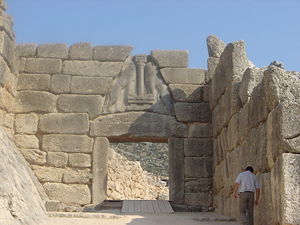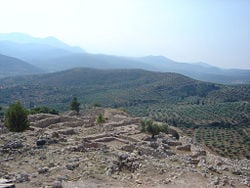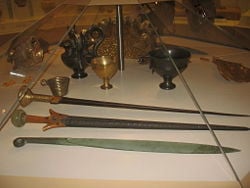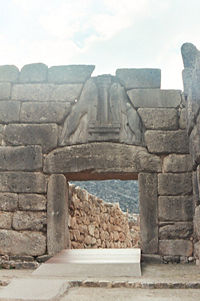Mycenae
 From Nwe
From Nwe | Archaeological Sites of Mycenae and Tiryns* | |
|---|---|
| UNESCO World Heritage Site | |
 |
|
| State Party | |
| Type | Cultural |
| Criteria | i, ii, iii, iv, vi |
| Reference | 941 |
| Region** | Europe and North America |
| Coordinates | |
| Inscription history | |
| Inscription | 1999 (23rd Session) |
| * Name as inscribed on World Heritage List. ** Region as classified by UNESCO. |
|
Mycenae (Greek Μυκῆναι), is an archaeological site in Greece, located about 90 km south-west of Athens, in the north-eastern Peloponnese. In the second millennium B.C.E., Mycenae was one of the major centers of Greek civilization, a military stronghold which dominated much of southern Greece. The period of Greek history from about 1600 B.C.E. to about 1100 B.C.E. is called Mycenaean in reference to Mycenae. According to legend, Mycenae was the capital city of Agamemnon, famous for his sacking of Troy during this time.
Mycenae was a powerful city-state, rivaling and later superseding that of Knossos, the center of Minoan culture on Crete. It was finally destroyed by warriors from Argos, becoming a tourist attraction in classical Greek and Roman times. Archaeologists in the nineteenth century began to excavate the site, and Heinrich Schliemann unearthed numerous beautiful artifacts, including the "mask of Agamemnon." Today, Mycenae is a World Heritage Site, again a tourist attraction this time for the world, where the beauty and magnificence of the works of the ancient people who inhabited this place are available for all to appreciate.
History

It is believed that Mycenae was settled by Indo-Europeans who practiced farming and herding, close to 2000 B.C.E., but little is known of these people and their cultures. At the same time, Minoan Crete developed a very complex civilization which interacted with Mycenae, and most likely influenced its development.
At some point in the Bronze Age, the civilization on Mycenae began to become more Hellenistic in nature. The settlement pattern changed into a fortified hill surrounded by hamlets and estates, instead of the dense urbanity present on the coast (such as at Argos). Soon, Mycenae incorporated local and small city-states into its civilization, such as Tiryns, Pylos, Thebes, and Orchomenos.[1] These city-states paid taxes to the Mycenaean rulers, pledged their allegiance to Mycenae, and provided soldiers in times of battle. Around this time, the first great palaces of the city were constructed. Due to its position in the Mediterranean, Mycenae became a central port of trade and economic growth flourished. It soon rivaled Knossos as a central power, both economically and militarily. The general consensus is that the Mycenaean civilization reached its pinnacle of power around 1400 B.C.E. This period is generally referred to as Late Helladic IIIA-IIIB.
Mycenaean civilization did not stay in power for long. By 1200 B.C.E., the civilization was in decline. There are numerous theories for this turnaround. Around this time, a series of catastrophes struck the entire Greek mainland. Nearly all of the palaces of southern Greece were burned, including the one at Mycenae, which is traditionally attributed to a Dorian invasion of Greeks from the north, although some historians now doubt that such an invasion took place. Another theory is that a drought caused the Mycenaean decline and that frustration with those in power caused the burning of granaries and palaces. Another theory is that the destruction of the palaces is related to the Sea People who destroyed the Hittite Empire and attacked the nineteenth and the twentieth dynasties of Egypt. The evacuation of the area was also due to the drought; although there is no climatological evidence for it other than lack of evidence for an invasion. Volcanic and geological activity, such as is sometimes attributed to the decline of Knossos, has also been thought to have caused the destruction of Mycenae.[2]
In the period, LHIIIC, also termed "submycenaean," Mycenae was no longer a power. Pottery and decorative styles were changing rapidly. Craftmanship and art declined. The citadel was abandoned at the end of the twelfth century, as it was no longer a strategic location, but only a remote one.
During the early Classical period, Mycenae was once again inhabited, although it never regained its earlier importance. Mycenaeans fought at Thermopylae and Plataea during the Persian Wars. In 462 B.C.E., however, troops from Argos captured Mycenae and expelled the inhabitants. In Hellenistic and Roman times, the ruins at Mycenae were a tourist attraction (just as they are now). A small town grew up to serve the tourist trade. By late Roman times, however, the site had been abandoned.
Excavation
The first excavations at Mycenae were carried out by the Greek archaeologist Kyriakos Pittakis in 1841. He found and restored the Lion Gate. In 1874, Heinrich Schliemann defied popular convention regarding Mycenae as a place of myth (just as the lost city of Troy had been considered) and used ancient texts and literature to discover the buried city. In conjunction with the Athens Archaeological Society, Schliemann discovered what is called Grave Circle A, in which he found royal skeletons and spectacular grave goods. Schliemann's discoveries, which included the "mask of Agamemnon," captured the attention of the academic world, igniting interest in ancient Greece, and is sometimes considered the foundation of Ancient Greece archeology.[3]
Since Schliemann's day, more scientific excavations have taken place at Mycenae, mainly by Greek archaeologists but also by the British School at Athens. The acropolis was excavated in 1902, and the surrounding hills have been methodically investigated by subsequent excavations, which have led to a wealth of information regarding Mycenae and Ancient Greece in general.
Architecture
Much of the earliest structures on the island no longer exist, and archaeologists have had to make educated guesses based on similar bronze age architecture contemporary to the time. There is evidence however, of a shift in style, which correlates to a shift in culture. Burial in tholoi (or beehive tombs) is seen as replacing burial in shaft graves, which has suggested the beginnings of the great empire to come. The care taken to preserve the shaft graves testifies that they were by then part of the royal heritage, the tombs of the ancestral heroes.
At a conventional date of 1350 B.C.E., the fortifications on the acropolis, and other surrounding hills, were rebuilt in a style known as "cyclopean," because the blocks of stone used were so massive that they were thought in later ages to be the work of the one-eyed giants known as Cyclops. Within these walls, parts of which can still be seen, monumental palaces were built. The palace (what is left of it) currently visible on the acropolis of Mycenae dates to the start of LHIIIA:2. Earlier palaces must have existed but they had been cleared away or built over.
The construction of palaces at that time with a similar architecture was general throughout southern Greece. They all featured a megaron, or throne room, with a raised central hearth under an opening in the roof, which was supported by four columns in a square around the hearth. A throne was placed against the center of one wall. Frescos adorned the plaster walls and floor.
The room was accessed from a courtyard with a columned portico. At Mycenae, a grand staircase led from a terrace below to the courtyard on the acropolis. One can easily imagine Clytemnestra rolling out the proverbial red carpet upon it, but there is no evidence beyond the stories of poets and playwrights where she might have rolled it, or whether she really did.
The pottery phases on which the relative dating scheme is based (EH, MH, LH, etc.) do not allow very precise dating, even augmented by the few existing C-14 dates. The sequence of construction of imperial Mycenae is approximately as follows. At the beginning of LHIIIB, around 1300 or so, the Cyclopean wall was extended to the south slope to include grave circle A. The main entrance through the circuit wall was made grand by the best known feature of Mycenae, Lion Gate, through which passed a stepped ramp leading past circle A and up to the palace. The Lion Gate was built in the form of a "Relieving Triangle" to support the weight of the stones. It went past some houses considered to be workshops now: The House of Shields, the House of the Oil Merchant, the House of the Sphinxes, and the West House. An undecorated postern gate was also constructed through the north wall.
Somewhat later, at the LHIIIB:1/2 border, around 1250 or so, another renovation project was undertaken. The wall was extended again on the west side, with a sally port and also a secret passage through and under the wall, of corbeled construction, leading downward by some 99 steps to a cistern carved out of rock 15 m below the surface. It was fed by a tunnel from a spring on more distant higher ground. The "Treasury of Atreus," so-called by Schliemann since it had long ago been looted of its contents that he did not realize it was a tomb, was constructed at about this time.
Religion
In many ways Mycenaean religion is still known, for much of it survives into classical Greece in the pantheon of Greek gods. However, the specifics of early Mycenaean religion is vague at best. Mycenaean religions were almost certainly polytheistic, and the Myceneans were actively syncretistic, adding foreign gods to their pantheon of gods with surprising ease. The Mycenaeans probably entered Greece with a pantheon of gods headed by some ruling sky-god. In Greek, this god would become Zeus.[4]
At some point in their cultural history, the Mycenaeans adopted the Minoan goddesses and associated these goddesses with their sky-god; scholars believe that the Greek pantheon of gods do not reflect Mycenaeans religion except for Zeus and the female goddesses, which are, however, Minoan in origin. In general, later Greek religion distinguishes between two types of gods: The Olympian or sky-gods, and the gods of the earth, or chthonic gods—these chthonic gods are almost all female. The Greeks believed that the chthonic gods were older than the Olympian gods; this suggests that the original Greek religion may have been oriented around goddesses of the earth, but there is no evidence for this outside of reasonable speculation.
Mycenean religion certainly involved offerings and sacrifices to the gods, and some have speculated that they involved human sacrifice based on textual evidence and bones found outside tombs. In the Homeric poems, there seems to be a lingering cultural memory of human sacrifice in King Agamemnon's sacrifice of his daughter, Iphigenia; several of the stories of Trojan heroes involve tragic human sacrifice.
Mythology
Legend asserts that Mycenae was founded by Perseus, grandson of king Acrisius of Argos, son of Acrisius' daughter, Danae. Having killed his grandfather by accident, Perseus could not or would not inherit the throne of Argos. Instead, he arranged an exchange of realms with his half-brother, Megapenthes, and became king of Tiryns, Megapenthes taking Argos. From there he founded Mycenae and ruled the kingdoms jointly from Mycenae.
Perseus married Andromeda and had many sons, but in the course of time went to war with Argos and was slain by Megapenthes. His son, Electryon, became the second of the dynasty, but the succession was disputed by the Taphians under Pterelaos, another Perseid, who assaulted Mycenae and, losing, retreated with the cattle. The cattle were recovered by Amphitryon, a grandson of Perseus, but he killed his uncle by accident with a club in an unruly cattle incident and had to go into exile.[5]
The throne went to Sthenelus, third in the dynasty, a son of Perseus. He set the stage for future greatness by marrying Nicippe, a daughter of king Pelops of Elis, the most powerful state of the region and the times. With her, he had a son, Eurystheus the fourth and last of the Perseid dynasty. When a son of Heracles, Hyllus, killed Sthenelus, Eurystheus became noted for his enmity to Heracles and for his ruthless persecution of the Heracleidae, the descendants of Heracles.
Mycenae has also been sometimes dubbed the "House of Agamemnon," the legendary warrior-king who played an integral part in Greek legend. To appease the gods, who would not grant wind so the Greek armies could sail against Troy, Agamemnon sacrificed his own daughter. Upon returning home after the successful sacking of Troy, Agamemnon's heartbroken wife, Clytemnestra, killed her husband to avenge his sacrificing of their daughter. In return, their son Orestes, had to weight the options of avenging his father against committing matricide.
Tourism
Today Mycenae, one of the foundational sites of European civilization, is a popular tourist destination, less than two hours' drive from Athens. The site has been well-preserved, and the massive ruins of the cyclopean walls and the palaces on the acropolis still arouse the admiration of visitors, particularly when it is remembered that they were built a thousand years before the monuments of Classical Greece.
Gallery
Notes
- ↑ Brian Mandelkow, MSU EMuseum, (2007), Mycenae. Retrieved October 5, 2007.
- ↑ Elizabeth French, Mycenae: Agamemnon's Capital: The Site and Its Setting (Tempus Publishing, 2002). ISBN 075241951X
- ↑ National Archaeological Museum Athens-Greece, (2007), Grave Circle A. Retrieved October 5, 2007.
- ↑ Richard Hooker, (1996), The Mycenaens: Mycenaean Religion. Retrieved October 5, 2007.
- ↑ Edith Hamilton, Mythology (1942). ISBN 0316341142
References
ISBN links support NWE through referral fees
- Bryson, Reid and Thomas J. Murray. 1977. Climates of Hunger. University of Wiconsin Press. ISBN 0-299-07370-X
- Chadwick, John. The Mycenaean World. Cambridge University Press, 1976. ISBN 0-521-21077-1
- Finley, M.I. 1981. Early Greece, The Bronze and Archaic Ages. W. W. Norton & Company. ISBN 0-393-01569-6
- French, Elizabeth. 2002. Mycenae: Agamemnon's Capital. Tempus, Stroud. ISBN 07524 1951 X
- Mylonas, George E. 1983. Mycenae Rich in Gold. Athens: Ekdotike Athenon.
- Mylonas, George E. 1968. Mycenae's Last Century of Greatness. Sydney University Press. ISBN 424-05820-3
- Nilsson, Martin P. 1932. The Mycenaean Origin of Greek Mythology. Reissued by the University of California Press. ISBN 0-520-01951-2
- Palmer, Leonard R. 1965. Mycenaeans and Minoans.
- Taylour, W.D., E.B. French, and K.A. Wardle. 2007. Well Built Mycenae. Oxford: Oxbow Books.
- Vermeule, Emily. 1964. Greece in the Bronze Age. The University of Chicago Press.
- Wace, A.J.B. [1949] 1964. Mycenae: An Archaeological History and Guide. Princeton.
- Wardle, K.A. and Diana. Cities of Legend: The Mycenaean World. Bristol Classical Press, 1997. ISBN 1-85399-355-7
External links
All links retrieved November 10, 2022.
- Mycenae: Research and Publication.
- Artifacts from Mycenae.
- The Entrance to the Citadel.
- The Design of the Palace.
Credits
New World Encyclopedia writers and editors rewrote and completed the Wikipedia article in accordance with New World Encyclopedia standards. This article abides by terms of the Creative Commons CC-by-sa 3.0 License (CC-by-sa), which may be used and disseminated with proper attribution. Credit is due under the terms of this license that can reference both the New World Encyclopedia contributors and the selfless volunteer contributors of the Wikimedia Foundation. To cite this article click here for a list of acceptable citing formats.The history of earlier contributions by wikipedians is accessible to researchers here:
The history of this article since it was imported to New World Encyclopedia:
Note: Some restrictions may apply to use of individual images which are separately licensed.
↧ Download as ZWI file | Last modified: 02/04/2023 02:16:58 | 3 views
☰ Source: https://www.newworldencyclopedia.org/entry/Mycenae | License: CC BY-SA 3.0
 ZWI signed:
ZWI signed:













 KSF
KSF